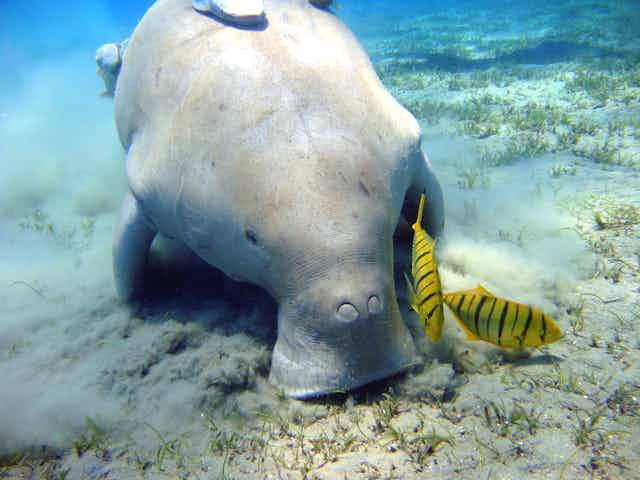Recent calls for a ban on legal traditional hunting of dugongs and marine turtles imply that hunting is the main threat to these iconic species in Australia. The science indicates otherwise.
While more is being done to address traditional hunting than any of the other impacts, the main threats to their survival often pass unnoticed.
The real threat to sea turtles
The draft Recovery Plan for Marine Turtles in Australia evaluated 20 threats to the 22 populations of Australia’s six species of marine turtle. Climate change and marine debris, particularly “ghost nets” lost or abandoned by fishers, are the greatest risks for most stocks.

Indigenous use is considered to be a high risk for three populations: Gulf of Carpentaria green turtles, Arafura Sea flatback turtles and north-eastern Arnhemland hawksbill turtles.
However, in each of these cases it is the egg harvest, not hunting, that causes concern. International commercial fishing is also a high risk for the hawksbill turtle, whose future remains uncertain. Traditional hunting of marine turtles in Australia is limited to green turtles.
Is hunting a threat?
The Torres Strait supports the largest dugong population in the world and a globally significant population of green turtles. Archaeological research shows that Torres Strait Islanders have been harvesting these species for more than 4,000 years and the dugong harvest has been substantial for several centuries.
Our research shows that the Torres Strait dugong population has been stable since we started monitoring 30 years ago and that the harvest of both species is sustainable.
The situation for dugongs is very different in the waters of the Great Barrier Reef south of Cooktown. The Great Barrier Reef Outlook Report classifies the condition of the dugong population in this region as poor.
Modelling indicates that the southern Great Barrier Reef stock of the green turtle, which live and breed south of Cooktown, is increasing.
Nonetheless, both green turtles and dugongs died in record numbers in the year after the extreme floods and cyclones of the summer of 2010-11. Dugongs stopped breeding in the Great Barrier Reef region south of Cooktown.
Thankfully, our current aerial survey indicates that dugong calving has resumed as inshore seagrass habitats recover. There is no evidence that the 2011 losses significantly affected green turtle numbers.
Working together
Traditional owners are the first managers of our coastal waters, with cultural practices extending back thousands of years. They have the most to lose from any loss of turtles and dugongs. It is therefore in their best interests, and the government’s best interest, to work in partnership to protect and sustainably manage these species.
Longstanding tensions between traditional owners and tourist operators are behind much of the opposition to traditional hunting in the Cairns area. Some of these tensions have been relieved by the Gunggandji Traditional Use of Marine Resources Agreement signed in June 2016.
Under this agreement, the traditional owners decided to cease hunting turtles and dugongs in the waters surrounding Green Island, Michaelmas Cay and Fitzroy Island.
The Gunggandji agreement is the seventh to be signed between the Great Barrier Reef Marine Park Authority and traditional owners. In addition, there are two Indigenous land use agreements that address hunting issues in the Great Barrier Reef.
In the Torres Strait, dugong and turtle hunting is managed through 14 (soon to be 15) management plans. There are similar agreements with traditional owners and management agencies in other regions in northern Australia.
Indigenous rangers are crucial to implementing all these agreements in collaboration with management agencies and research institutions. Rangers deliver the practical, on-the-ground arrangements to conserve these species in their Sea Country.
The Great Barrier Reef Marine Park Authority has implemented an Indigenous Compliance Program that authorises trained Indigenous rangers to respond to suspicious and illegal activities that they encounter as part of their work.

Indigenous rangers also remove marine debris from remote beaches. The community-based organisation GhostNets Australia has worked with 31 coastal Indigenous communities to protect over 3,000km of northern Australia’s saltwater country from ghost nets. These community projects have been instrumental in rescuing turtles, clearing ghost nets off beaches and identifying key areas to aid management agencies to better understand the impact.
Traditional owners from the Torres Strait and the northern Great Barrier Reef also play a valuable role in intervention works at Raine Island, one of the world’s most significant green turtle rookeries. This includes rescuing stranded turtles, using fences to stop turtles from falling over cliffs, and altering beach profiles.
What about welfare?
Traditional hunting raises animal welfare issues. The turtle and dugong management plans developed by the Torres Strait communities explicitly address animal welfare. The Torres Strait Regional Authority has been working with a marine mammal veterinarian and traditional owners to develop additional methods of killing turtles humanely.
Indigenous hunters who breach state and territory animal welfare laws can be prosecuted. But more widespread animal welfare problems, not associated with hunting, are largely hidden and ignored. The Queensland Strand Net Program reported that 879 turtles died of their wounds from vessel strike between 2000 and 2011.

Other serious animal welfare issues are associated with animals drowning in nets and being caught in and ingesting marine debris. In addition, the potential impact of emerging threats like underwater noise pollution and water quality remain as substantial knowledge gaps. These matters tend not to make the headlines.
Australian waters are home to some of the world’s largest populations of marine turtles and dugongs. A comprehensive and balanced approach to their conservation and management is required to enable our grandchildren and their children to enjoy these amazing animals.

